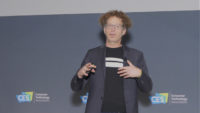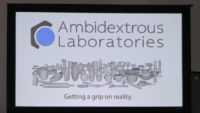CES 2020: ‘Robots for Good’ Advocates See Hopeful Future
January 7, 2020
A conference on “Robots for Good” sought to allay increased fears that robot overlords will soon rule the world and make humans redundant in the workforce. UC Berkeley professor Ken Goldberg, who heads a robotics lab there, spoke about his “radically hopeful vision of the future.” Robots will not replace humans, he said, but rather enable people to focus on what they do best: creativity, innovation, empathy and other inherent human traits. Goldberg also put the fear of robots in historical perspective.
“The word ‘robot’ was coined 100 years ago in 1920 by Czech playwright Karel Čapek,” said Goldberg (below). He reminded attendees that “fear of robots goes back to the ancient Greeks.” “Don’t forget there was great fear around ATMs, spreadsheets and barcodes that they would replace humans,” he said. “And they did not, just as AI will not wipe out truck or taxi drivers. We’re in danger of underrating humans.”

Google’s DeepMind beating a human expert at the game of “Go” fueled the beginning of a new round of anxiety about robots. “’Go’ is a very complicated game with a huge branching factor,” he explained. “Google used massive amounts of computing plus deep learning.”
But this is radically different from real-world scenarios such as driving cars, working in factories or conducting surgeries, he pointed out. Whereas “Go” is a 19×19 static grid with a limited number of choices, real life use cases are much more complex and dynamic.
At Goldberg’s UC Berkeley AUTOLAB, he and his graduate students watch robots fail all the time (he quoted a 99 percent fail rate). At the same time, he noted, surgical assistant robots performed 1 million surgeries last year — every single one of them with a human surgeon. “There are levels of autonomy, in surgery and driving,” he said. But the assistant tasks can improve the outcome; his lab is working on better, consistent suturing.
“We collect data from the best surgeons in the world,” he said. “It will be better facilitated by 5G, which will increase bandwidth and decrease latency.”
The cloud has potential to facilitate robots in all kinds of applications, which will make it easier to access big data; Amazon is developing RoboMaker, which provides tools for managing cloud robotics with AWS. Goldberg described his own vision of balancing the edge layer and the cloud, which he dubbed Fog Robotics.
He also described his lab’s work in a major bottleneck in e-commerce: getting products to people in a timely manner. “Robots need to be able to pick up all kinds of objects,” he said. “But a combination of physics, perception and control issues make robots very clumsy.”

At Google’s Arm Farm, 16 robot arms learn by trying to grasp objects 24/7. But although the failure rate plummeted to 20 percent after 10 million grasps, the time to a useful error rate will take 100 years. Goldberg’s Dexterity Network is enabling much faster simulation that can do millions of grasps in hours and has formed Ambidextrous Laboratories to commercialize the technology.
Referencing the study that showed a new system that beats radiologists at diagnosing breast cancer, Goldberg noted that it’s not a competition between humans and robots. “Robots are good at calculations, precision and objectivity,” he said. “Humans have dexterity, understanding and empathy.”

No Comments Yet
You can be the first to comment!
Sorry, comments for this entry are closed at this time.